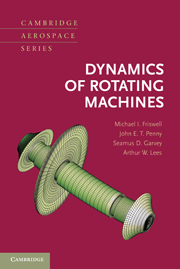Book contents
- Frontmatter
- Contents
- Preface
- Acronyms
- 1 Introduction
- 2 Introduction to Vibration Analysis
- 3 Free Lateral Response of Simple Rotor Models
- 4 Finite Element Modeling
- 5 Free Lateral Response of Complex Systems
- 6 Forced Lateral Response and Critical Speeds
- 7 Asymmetric Rotors and Other Sources of Instability
- 8 Balancing
- 9 Axial and Torsional Vibration
- 10 More Complex Rotordynamic Models
- Solutions to Problems
- Appendix 1 Properties of Solids
- Appendix 2 Stiffness and Mass Coefficients for Certain Beam Systems
- Appendix 3 Torsional Constants for Shaft Sections
- Bibliography
- Index
5 - Free Lateral Response of Complex Systems
Published online by Cambridge University Press: 05 February 2015
- Frontmatter
- Contents
- Preface
- Acronyms
- 1 Introduction
- 2 Introduction to Vibration Analysis
- 3 Free Lateral Response of Simple Rotor Models
- 4 Finite Element Modeling
- 5 Free Lateral Response of Complex Systems
- 6 Forced Lateral Response and Critical Speeds
- 7 Asymmetric Rotors and Other Sources of Instability
- 8 Balancing
- 9 Axial and Torsional Vibration
- 10 More Complex Rotordynamic Models
- Solutions to Problems
- Appendix 1 Properties of Solids
- Appendix 2 Stiffness and Mass Coefficients for Certain Beam Systems
- Appendix 3 Torsional Constants for Shaft Sections
- Bibliography
- Index
Summary
Introduction
In this chapter, we examine the characteristics of complex rotor–bearing systems in the absence of any applied forces. Chapter 3 shows how the characteristic dynamic behavior of simple rotors can be computed. As the rotor–bearing system becomes more complicated, the corresponding system model also becomes more complicated. The normal approach to handling this increased complexity is to discretize the system in a systematic way so that an approximate model can be created with a finite (but possibly large) number of coordinates. In the past, the transfer matrix method (or its predecessors: the Holtzer method for torsional analysis and the Myklestad-Prohl method for lateral analysis) were used for this purpose. With the increase in computing power in the last three decades, the FEM has become the de facto standard method for the static and dynamic analysis of structures as well as for the analysis of rotor–bearing systems. In this book, we choose to concentrate exclusively on the application of the FEM to model rotor–bearing systems. Example applications of the FEM to rotating machinery may be found in the works of Lalanne and Ferraris (1999), Nelson (1980), and Nelson and McVaugh (1976).
The problem of creating an adequate model of a rotating machine is considered and the model is then analyzed to determine its dynamic characteristics. By “dynamic characteristics,” we mean the natural frequencies, the corresponding mode shapes, and the free response of the system. In Chapters 6, 7, and 8, we examine the effect of lateral forces acting on the rotor.
- Type
- Chapter
- Information
- Dynamics of Rotating Machines , pp. 155 - 227Publisher: Cambridge University PressPrint publication year: 2010
- 3
- Cited by



